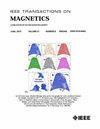Physics-Informed Neural Network for Solving 1-D Nonlinear Time-Domain Magneto-Quasi-Static Problems
IF 2.1
3区 工程技术
Q3 ENGINEERING, ELECTRICAL & ELECTRONIC
引用次数: 0
Abstract
The nonlinear (NL) magnetic material law is crucial for an accurate estimation of the core losses in electromagnetic devices. However, this law comes with a certain level of uncertainty. Conventionally, the experimental material data are fit in parameterized material models that are then integrated in computational field methods, e.g., finite elements. In this article, we aim to explore the capabilities of physics-informed neural networks (PINNs) for characterizing magnetic materials. Therefore, we consider a 1-D time-domain magneto-quasi-static (MQS) problem including saturation and hysteresis. The governing partial differential equations (PDEs) together with the initial conditions (ICs) and boundary conditions (BCs) are incorporated into the PINN loss function, resulting in an optimization procedure. Particular attention is paid to the computation of derivatives, studying the performance of automatic differentiation (AD) and finite difference (FD). A 1-D FE solution serves as validation.求解一维非线性时域磁准静态问题的物理信息神经网络
非线性磁性材料定律是准确估计电磁器件铁芯损耗的关键。然而,这项法律也有一定程度的不确定性。通常,实验材料数据被拟合在参数化的材料模型中,然后集成到计算领域的方法中,例如,有限元。在本文中,我们的目标是探索物理信息神经网络(pinn)表征磁性材料的能力。因此,我们考虑一个含饱和和磁滞的一维时域准静态问题。将控制偏微分方程(PDEs)、初始条件(ICs)和边界条件(bc)结合到PINN损失函数中,得到优化过程。特别关注导数的计算,研究了自动微分和有限差分的性能。一个1-D有限元解决方案作为验证。
本文章由计算机程序翻译,如有差异,请以英文原文为准。
求助全文
约1分钟内获得全文
求助全文
来源期刊

IEEE Transactions on Magnetics
工程技术-工程:电子与电气
CiteScore
4.00
自引率
14.30%
发文量
565
审稿时长
4.1 months
期刊介绍:
Science and technology related to the basic physics and engineering of magnetism, magnetic materials, applied magnetics, magnetic devices, and magnetic data storage. The IEEE Transactions on Magnetics publishes scholarly articles of archival value as well as tutorial expositions and critical reviews of classical subjects and topics of current interest.
 求助内容:
求助内容: 应助结果提醒方式:
应助结果提醒方式:


